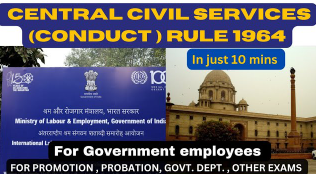
Leave Not Due
The rules regarding Leave Not Due (LND) for Central Government employees are framed to provide support in times of urgent need, especially in situations where the employee has exhausted all earned and half-pay leaves but still requires leave on medical or other genuine grounds. Swamy’s Handbook, a well-regarded guide for Central Government rules and service regulations, explains the conditions and processes associated with Leave Not Due in a clear and structured manner.
Leave Not Due is essentially a type of leave granted in anticipation of future half-pay leave (HPL) that the employee will earn later in their service. It is most commonly availed in cases of prolonged illness or emergencies where all other leave balances have been used up. However, this provision is not freely granted to everyone; it comes with specific conditions and eligibility criteria to prevent misuse and maintain discipline in the leave structure.
According to the rules mentioned in Swamy’s Handbook, Leave Not Due is granted only on medical grounds and is permissible for employees who do not have any Half Pay Leave at their credit. It is a leave that is “borrowed” from the future, subject to the employee’s return to duty and the ability to earn sufficient half-pay leave to “repay” it. One of the most important eligibility conditions is that the employee must be confirmed or regular in service. Temporary employees are generally not entitled to Leave Not Due, except in cases of exceptional merit or circumstances, and even then, it may require prior approval from the competent authority.
The quantum of Leave Not Due that can be availed is limited. Swamy’s Handbook clarifies that Leave Not Due shall not exceed 360 days during the entire service period of an employee. Moreover, such leave is debited against future half-pay leave that the employee will earn later, and if the employee retires or resigns before earning the requisite amount of half-pay leave, the excess LND granted may be adjusted against the leave encashment or recovered otherwise. It is important to note that this leave is only granted when there is a reasonable certainty that the employee will return to duty and will continue in service long enough to earn the necessary half-pay leave for adjustment.
Swamy’s Handbook further outlines that the competent authority, typically the Head of Office or the Appointing Authority, has the discretion to grant Leave Not Due. The decision is taken based on the nature of illness, recommendations from the Authorized Medical Officer, and service records. The authority must also ensure that such leave is not misused and the employee has a genuine requirement. In the absence of medical certification, Leave Not Due cannot be sanctioned.

For women employees, especially during the probation period or when maternity leave has been exhausted, LND may be considered sympathetically, again, strictly on medical grounds and with assurance of continued service. However, it cannot be granted casually or for non-medical purposes such as personal travel or vacation. The primary intent behind Leave Not Due is to assist employees during health-related emergencies where all available leave options have already been availed.
Swamy’s Handbook also stresses the importance of record maintenance in leave accounts. When Leave Not Due is granted, proper entries must be made in the Service Book and leave register, indicating that the leave is to be adjusted against future accruals. Any deviation or error in maintaining records could lead to discrepancies in service benefits, particularly at the time of retirement or resignation.
In the event of an employee’s death while in service, the LND availed is not recovered from family pension or death gratuity. This provision ensures fairness and compassion toward the bereaved family and underlines the Government’s welfare approach.
To summarize, Leave Not Due is a critical provision available under the Central Civil Services (Leave) Rules and extensively detailed in Swamy’s Handbook. It is a supportive mechanism meant for genuine medical cases, where employees can continue their recovery without the pressure of leave shortage. However, it is governed strictly by conditions of eligibility, confirmation status, medical justification, and administrative discretion. The leave is to be seen as an exception rather than a routine facility, meant to assist employees in distress without burdening the exchequer or encouraging misuse.
Central Government employees are encouraged to familiarize themselves with the conditions under which LND can be granted, and the responsibilities that come with availing such leave. By following the rules laid out in Swamy’s Handbook, employees and administrative authorities can ensure that the process remains transparent, fair, and beneficial to those who truly need it.
Please don’t forget to leave a review.

Disclaimer:
This blog post is intended for informational purposes only. All rights, references, and credits related to official government service rules and guidelines belong to Swamy’s Publications, the authoritative source on these matters. We acknowledge and extend our courtesy to Swamy’s Publication for their valuable work in compiling and publishing official content. This blog does not claim ownership or authorship of any content originally published by Swamy’s Publications.
For more information and updates please follow the page and don’t forget to leave your comment.
